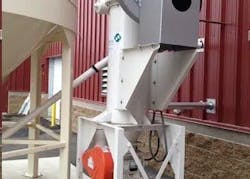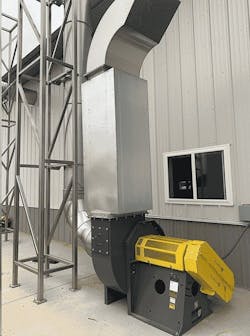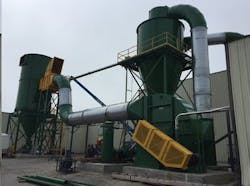The Different Types of Dust Collection Methods for Bulk Dry Food Manufacturing
Dust collection systems remove dust and other particulate matter from the air and are very important for many companies and industries at large. They come in many forms and configurations for different applications and materials. But, at the highest level, they can be divided into three types of solutions:
- Cartridge Dust Collectors: Use pleated filters, like the ones you're used to seeing in your car or home. They filter to small particles, consume little space, and are easy to maintain, but will fill quickly in high-volume applications.
- Baghouses: Using a series of bags, baghouses filter large volumes of dust to very small particle sizes, but they require a large footprint, and bag changes typically require a service provider.
- Cyclone Dust Collectors: Using centrifugal force to remove particles, cyclone dust collectors accommodate huge volumes with low maintenance and without the bag changes, but they’re large and let small particles through.
Comparing Methodologies
Given that there are several different types of dust collection systems available, each type has its unique advantages and disadvantages, making some better suited at certain tasks than others.
Here are some key considerations.
Cartridge
Cartridge dust collectors are a type of dust collection system that uses pleated filters, known as cartridges, to trap and remove dust and other particles from the air. These systems work well for a variety of industrial and commercial environments, including woodworking shops, metalworking shops, and food processing facilities.
One of the major benefits of cartridge dust collectors is their high efficiency in removing dust and other particulate matter from the air. Because the cartridges are made of a porous material, they can trap and remove a wide range of particle sizes—from fine dust to larger particles. Additionally, cartridge dust collectors take up little space and it's very easy to swap the filters. The downside is that these filters will clog more frequently and are not practical for high-volume applications.
Cyclone
Cyclone dust collectors, also known as cyclonic separators, use centrifugal force to separate dust and other particles from the air. These systems work by drawing dirty air into a cylindrical chamber, where the air is then spun at a high velocity. This spinning motion causes the heavier dust and particles to be thrown into the walls of the chamber, where they can be collected and removed.
Cyclone dust collectors are well-suited for use in applications where a large volume of heavy dust and debris needs to be removed, such as in woodworking or metalworking operations. They are relatively simple in design, easy to maintain, and have a low running cost. However, they are rather large and are not as efficient in removing fine dust particles as compared to the other methods because they don't use bags. For this reason, some processors who continuously generate a lot of dust but also need everything filtered will pair a cyclone filter with another option for a 2-stage solution.
Baghouses
Baghouses, also known as fabric filter dust collectors, use a series of filter bags to trap and remove dust and other particles from the air. These systems work by drawing dirty air through the filter bags, which are made of a porous material that captures dust and other particles. Baghouses are well-suited for use in applications where a high degree of filtration is required, such as in cement plants, power plants, flour milling, and other industrial operations. They're efficient in capturing fine dust particles but are relatively high maintenance as the filter bags usually cannot be replaced by laymen.
The considerations to be made with baghouses are footprint and maintenance cost. But if you have room outside your facility and a service agreement with an apt provider, these pains can be alleviated without much trouble. For these reasons, baghouses are the popular solution.
When Dust Collection Is Needed
As cited above, each type of dust collection system has its unique advantages and disadvantages. Cartridge dust collectors are known for their high efficiency, low maintenance, and ability to remove a wide range of particle sizes. Cyclone dust collectors are well-suited for heavy dust and debris removal and have a simple design and low running cost. Baghouses are efficient in capturing fine dust particles but require more maintenance. The choice of dust collection system will depend on the specific requirements of the application and the type of dust or particles that need to be removed.
- Regulatory Compliance: Many industries are subject to strict regulations regarding air pollution and emissions, and a dust collection system can help companies comply with these regulations by removing dust and other particulate matter from the air.
- Safety/Liability: Dust and other particulate matter can be hazardous to workers' health, and a dust collection system can help to reduce the risk of respiratory problems and other health issues by removing these particles from the air.
- Equipment Protection: Dust and other particulate matter can damage equipment and machinery, and a dust collection system can help extend the life of equipment by removing these particles from the air.
- Product Quality: Dust and other particulate matter can negatively impact product quality, and a dust collection system can help to ensure that products are free from contaminants by removing these particles from the air.
- Janitorial Savings: Dust removed from the air is dust removed from surfaces. Catching the dust before it escapes saves the cleaning staff a lot of time and effort.
- Pest Prevention: In food processing applications, dust collection is worth it even if just to deter pests because, once you house them, it can be nearly impossible to eliminate them.
- Energy Efficiency: Dust and other particulate matter can clog filters and other components of heating, ventilation, and air conditioning (HVAC) systems, leading to decreased energy and equipment efficiency. A dust collection system can help to improve energy efficiency by removing these particles from the air.
- Fire prevention: Dust and other particulate matter can be a fire hazard, particularly in industries that reduce the particle size of flammable materials like wood and grains. A dust collection system can help to reduce the risk of fire by removing these particles from the air.
- Environmental Concerns: Dust and other particulate matter from metals and chemicals can be harmful to the environment, and a dust collection system can help to reduce the environmental impact of industrial and commercial operations by removing these particles from the air.
- Cost Savings: Dust and other particulate matter can lead to increased maintenance and repair costs, as well as decreased energy efficiency. A dust collection system can help to reduce these costs by removing these particles from the air.
Integrated dust collection systems are a consequential component of bulk dry solids processing facilities, ensuring that particles don't get into the air and on the facility floor. This makes breathing easier, reduces the risk of slipping, and, depending on the application, will reduce explosion risk or attraction of pests. By effectively capturing airborne particles, a cleaner and safer work environment is ensured.
About the Author
John Hilgendorf
Marketing Manager, ABM Equipment
John Hilgendorf is the Marketing Manager for ABM Equipment, a process engineering and integration firm with 40 years of experience in the food industry. With 7 years of sector expertise, John handles all marketing and communications initiatives at ABM, a leading bulk dry solids handling and processing equipment solutions purveyor providing full-service system design, fabrication, integration, and maintenance, including that related to dust collection systems. John may be reached at https://abmequipment.com.


